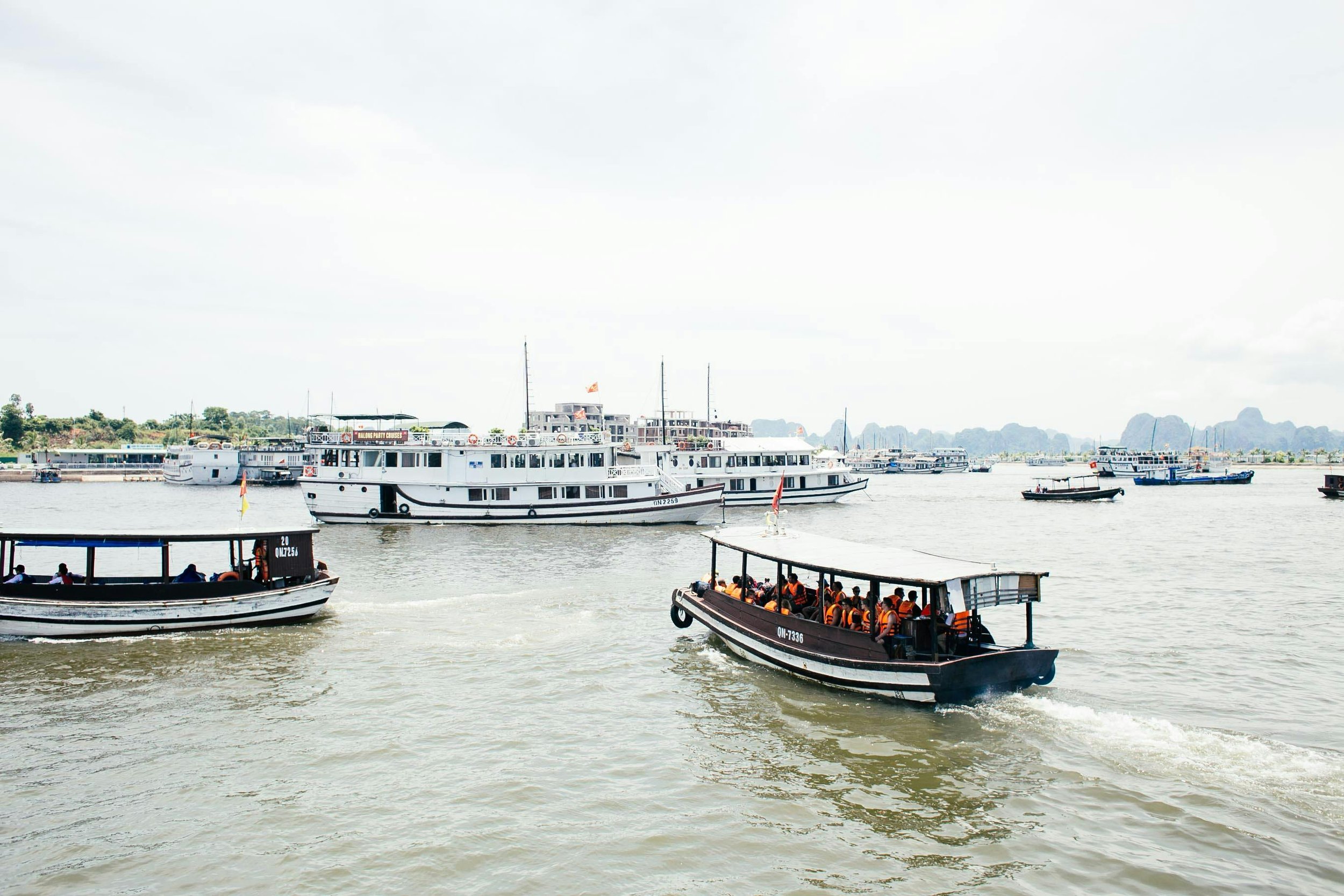With Australian surf spots under threat from climate change, opportunities arise for civilian activism.
Read MoreKashmir’s Climate Crisis: Where Environmental Stress Meets Political Tension
As glaciers melt and weather patterns shift, Kashmir and surrounding regions face increasing risks to water, agriculture and peace.
Read MoreThailand’s Smog Problem
With gray, smog-covered skylines, the tropical country and its citizens are facing serious pollution issues.
Read MoreClimate Change Threatens Popular Tourist Sites
As global temperatures increase and sea levels rise, some of the world’s most famous destinations are at risk.
Read MoreUrban Heat Islands: Cities Grapple with Rising Temperatures
Cities tend to be hotter on average than rural areas as a result of their infrastructure, and the warming of our climate is only making it worse.
Read MoreCan AI Fight Climate Change Without Fueling It?
As AI’s energy demands soar, it is increasingly necessary to find ways to green the technology before it's too late.
Read MoreExtreme Heat: A Growing Global Risk
Amidst rising temperatures and climate shifts, understanding their impact on people and the environment is crucial.
Read MoreAt The Frontlines of Climate Change: The Middle East
The Middle East is bearing the brunt of climate change, heating up at twice the global rate and navigating devastating fallout from droughts, displacement and conflict.
Read MoreCanada’s Smoke Signals: The Nation’s Escalating Wildfire Crisis
From breathing hazards to burned forests, the consequences of Canada’s wildfires are far-reaching and long-lasting.
Read MoreThe Hidden Climate Cost of Namibia and Botswana’s Oil Refinery
Energy independence for southern Africa could boost local economies, but oil refinery aspirations hold a hidden cost, contributing to greater climate issues.
Read MoreCarbon Credits Aren’t as Green as They Seem
Carbon credits are a tool to reduce emissions, but they tend to carry more weight as a marketing tactic rather than a sustainable practice.
Read More10 Places to See Before They Disappear
The casualties of industrialization and climate change.
Read MoreVietnam’s Floating Markets Are Disappearing
Kennedy Kiser
Climate change, migration and tourism are reshaping life on the Mekong Delta’s rivers.
Bananas being traded at the Cai Be floating market in Vietnam. McKay Savage. CC BY 2.0.
In Vietnam’s Mekong Delta, boats once crowded with fruits, vegetables and steaming bowls of noodle soup now drift by in dwindling numbers. The iconic floating markets, such as Cai Rang in Can Tho, are in decline. Rising sea levels and saltwater intrusion have transformed daily life in the delta, threatening these vibrant centers of commerce and culture. These markets have been around for generations, and in the 1990s, were major trade hubs. But today, many of these boats are gone.
The decline is largely environmental. The Mekong Delta, which supplies half of Vietnam’s rice and a third of its GDP, is being overwhelmed by rising sea levels and saltwater intrusion. Climate change has intensified these threats, but human activity plays a role too. According to Environmental Law Alliance Worldwide, the overuse of groundwater, upstream hydropower dams and sand mining have all accelerated the erosion and subsidence of the delta. As saltwater continues to creep further on land, fertile rice paddies turn sterile and make freshwater harder to access. For boat vendors, this means fewer crops to sell, higher transportation costs and increasingly unreliable river routes.
Saltwater intrusion impacts farmland in Vietnam’s Mekong Delta. AFP. CC BY 4.0.
This decline in floating markets severely impacts local families, especially those who depend on the markets. Many vendors face dwindling incomes, leading to increased migration to urban areas in search of better opportunities. For instance, Nguyen Thi Thuy, a former farmer, was forced to leave her home due to saltwater intrusion and now works as a security guard in Ho Chi Minh City. Just a decade or two ago, her income from selling fruit on the water would have been enough to sustain a family.
Aerial view of storm surge over Thi Nai Bay, Quy Nhon, 1969. Bill Gann. CC BY 2.0.
Adding to this shift is an increasing generational divide. Many younger residents no longer see a future in river-based life. Education and tech-based jobs in the cities hold more appeal than selling local produce. In part, local governments are struggling to maintain these markets as an increasing number of vendors’ children choose to leave instead of inheriting the family business. As fewer people choose to stay, the floating communities face cultural erosion.
Passenger ferries at a harbor in Vietnam. Rachel Claire. CC0.
Tourism presents both challenges and opportunities for the preservation of floating markets. While increased tourist interest can provide economic benefits, it can also lead to cultural commodification and environmental degradation. Some markets that have become more tourist-oriented have, in turn, seen their authenticity and traditional practices diminish.
However, efforts are underway to balance tourism development with cultural preservation. In 2016, the Can Tho City People’s Committee approved the Preserving and Developing Cai Rang Floating Market project. This project aims to promote tourism and environmental hygiene while transforming Cai Rang into a “hub for the Mekong Delta’s agricultural products.”.
The future of Vietnam’s floating markets hinges on sustainable practices that honor their cultural significance while adapting to environmental realities. Community engagement, responsible tourism and environmental conservatism are key to ensuring the survival and success of these markets. As the Mekong Delta navigates the challenges of climate change, preserving the unique heritage of its floating markets remains crucial.
Boats at the Cai Rang floating market in Can Tho, Vietnam. pixiduc. CC BY 2.0.
For travelers hoping to experience the floating markets, visiting with care and intention matters. Cai Rang in Can Tho remains the largest and most accessible market. It is best visited early in the morning when trading is at its peak. Smaller markets like Phong Dien offer a local, less touristy atmosphere and are perfect for travelers seeking a quieter glimpse of daily life. Opt for small, locally operated boat tours and avoid bringing single-use plastics that could end up in the river. Supporting vendors by buying fresh produce or food dishes directly from their boats will not only enhance your experience but also help maintain these communities. By traveling mindfully, visitors can help preserve the spirit of Vietnam’s floating markets for generations to come.
Kennedy Kiser
Kennedy is an English and Comparative Literature major at UNC Chapel Hill. She’s interested in storytelling, digital media, and narrative design. Outside of class, she writes fiction and explores visual culture through film and games. She hopes to pursue a PhD and eventually teach literature! @kennedy_kiser
Coastal Residents Bear the Brunt of Climate Change
Coastal communities worldwide are grappling with the widespread effects of a warming climate and rising sea levels, witnessing the devastation of their homes and increased economic difficulties.
Read MoreHow Countries Are Using AI to Manage Natural Disasters
Countries worldwide are leveraging AI and machine learning to enhance natural disaster management and resilience, with initiatives like the Global Initiative on Resilience to Natural Hazards through AI Solutions leading the way.
Read MoreA Portable Solution to the World’s Water Crisis
Hydro Wind Energy’s Quench Sea device offers a portable solution to the global water crisis, providing communities with access to clean drinking water through innovative desalination technology.
Read MoreSacred Duty: Religious Groups Fighting Fossil Fuels
As the climate crisis continues to worsen, religious climate justice organizations are taking a stand against environmental degradation.
GreenFaith protesting outside of BlackRock in 2022. Felton Davis. CC 2.0.
Over the past few years, the environmental crisis has begun to spiral out of control. As droughts and wildfires compete for attention with raging hurricanes across the United States, sometimes it can feel like the world is ending. But in the face of these natural disasters, people have started to come together, calling for an end to policies aggravating the climate crisis.
Religious teachings surrounding the sanctity and sacredness of Earth have long been folded into protests against the warming climate. Since the 1970s, religious organizations in the United States (primarily Christian and Jewish, although a few Islamic groups have also begun to speak out) have decried humanity’s destruction of the planet. Some, like the National Association of Evangelicals, have gone so far as to denounce those engaging in climate change-fueling activities as sinners.
It is important to note that many religious institutions remain largely disconnected from the climate crisis, with several organizations and churches denouncing it as a hoax. The groups mentioned in this article, and those like them, are largely outliers. Climate change continues to be a divisive topic at best in larger religious dialogues, as many consider the crisis a part of God’s plan or even an outright lie. However, religious climate change advocacy has grown in recent years, with small groups cropping up all over the United States.
Over the past few decades, these groups have grown more and more vocal. From organizing movements to protect the Endangered Species Act to founding an interfaith collective for climate justice, religious leaders and organizations across the United States have continued to take environmental action over the past four decades. Recently, in the summer of 2024, Christian and Jewish protesters in New York City made some of the greatest progress so far.
GreenFaith, an interfaith climate justice organization based in New Jersey, spent much of the summer of 2024 on Wall Street protesting against Citigroup. One of the largest banks in the United States, Citigroup released a statement in 2021 pledging to reach net zero emissions in 2050. However, independent researchers have pointed out that in the years since this pledge, the corporation has instead become the second-biggest investor in fossil fuels.
In response, several organizations joined together in the Summer of Heat demonstrations. Forty major protests were held outside Citigroup’s headquarters, led by a collection of religious leaders from GreenFaith, Dayenu (a Jewish organization comprised of longtime activists), and several other groups. The protests were held according to religious practices — songs replaced chanting, many of the protestors brought candles and demonstrators gathered in the early morning to block the doors of the banks. In an inspiring moment, a group of protestors arrived with signs displaying various religious symbols, representing the star of David, crosses and Islamic peace symbols.
These protests ultimately caught the attention of Citigroup’s administration, culminating in a sit-down between Citigroup’s chief sustainability officer and four leaders of the involved religious groups. According to reports, Citigroup rejected the protester’s proposals outright, refusing to answer whether or not they would change their commitment to funding fossil fuel companies.
However, this rejection does not diminish the Summer of Heat’s influence. These organizations gathered together and staged one of the longest climate protests in recent history. In addition, the actions of GreenFaith, Dayenu and the other involved groups gave a tremendously loud voice to their concerns, capturing the attention of many major news networks and eventually working their way into Citigroup itself. While their efforts may not have produced the results the groups hoped for, the Summer of Heat has nonetheless called an immense amount of attention to the climate crisis and the multicultural, interfaith movements working to protect the planet.
Ryan Livingston
Ryan is a senior at The College of New Jersey, majoring in English and minoring in marketing. Since a young age, Ryan has been passionate about human rights and environmental action and uses his writing to educate wherever he can. He hopes to pursue a career in professional writing and spread his message even further.
Fanning the Flames: Heat Waves Across America Set to Get Worse
An unending barrage of heat waves has pummeled North America in 2024, with climate change the likely culprit.
The sun rises on another 100-degree day in California. Pixabay. CC0
Climate change is an ongoing and severe crisis that is affecting all parts of the globe in different ways. From rising sea levels to increasingly chaotic weather patterns, every part of human society is at risk of some adverse effects.
North America has been suffering droughts on the west coast and frequent hurricanes and tornadoes on the east, but the entire continent is united in facing historically high temperatures. Almost the entire month of July has seen a solid string of heat waves, appearing in every corner of the continent. According to the United States Environmental Protection Agency (EPA), these heat waves have become far more frequent in the last few years, rising from two waves yearly in the 1960s to around six annually in the 2010s. In addition, heat waves have become more intense over the last few decades, with temperatures in Mexico and Central America brushing 125 degrees Fahrenheit in a historic first. Las Vegas also recently witnessed a record-breaking 115 degree day on July 12th, topping off a seven-day streak of broken records.
And these heat waves are only set to continue. As of the time of writing, heat waves are expected to renew their assault on the west coast, with temperatures projected to reach up to 110 degrees Fahrenheit and effect Washington, Nevada, Oregon, Arizona, Idaho and California. In 2023, Las Vegas never dropped from 100 degrees during the entire month of July, while this year’s forecast suggests that the average will have risen to 103 degrees by the end of the month. In addition, July 20th saw parts of Florida setting daily temperature records at around 97 degrees. This is a solid increase across the board for this time of year, with those same parts of Florida sitting at around a mean temperature of 84.9 degrees last year.
The biggest immediate threats presented by the rising temperatures, however, are wildfires. Hot and dry conditions naturally portend fires, and the already dangerous wildfire seasons in California and Canada have only gotten worse as the heat steadily increases. As of July 21st, several wildfires are raging in Oregon and western Canada, and incoming thunderstorms are predicted to make things substantially more difficult for the firefighters struggling to contain the blazes.
Although official statements stop short of absolute certainty, the vast majority of organizations are pinning the blame for these heat waves squarely on climate change. A series of incidents—the rising frequency and intensity of heat waves across the globe over the last few years, reports from 2022 about sidewalks melting in Europe, and 2023's historically devastating Canadian wildfire season—have raised concerns about the damage climate change can do even in the short term. That 2024's heat waves have been worse are suggestive of what is to come.
According to the Canadian Climate Institute, climate change has been proven to raise the frequency of severe heat waves, as well as slowing them down and causing them to linger over certain areas. Additionally, a statement released by the World Weather Attribution suggests that wildfire risk has become significantly higher as a result of climate change, making 2023’s wildfire season in Quebec close to 50% more intense.
It is becoming increasingly clear how rapidly climate change is altering the planet. Heat waves have been increasing in severity for the past few years, with 2023 setting global heat records and 2024 looking to blow even those historic numbers out of the water. These events are becoming increasingly common as time goes on, and it is possible that global average temperatures will rise five degrees by 2050, and around 10 degrees by the end of the century. Even the deviations we’re experiencing now are severe, but it looks like the world is going to get even hotter—and fast.
Ryan Livingston
Ryan is a senior at The College of New Jersey, majoring in English and minoring in marketing. Since a young age, Ryan has been passionate about human rights and environmental action and uses his writing to educate wherever he can. He hopes to pursue a career in professional writing and spread his message even further.
The Cost of Climate Change: Forced Relocation in Panama’s San Blas Islands
Rising sea levels led to the evacuation of about 300 Indigenous Guna families from Gardi Sugdub Island off the coast of Panama on June 1, 2024.
Gardi Sugdub, Panama. Lee Bosher. ATTRIBUTION-NONCOMMERCIAL 2.0 GENERIC
Climate change poses a threat to coastal territories around the world, as warming global temperatures lead to rising sea levels and stronger storms. Gardi Sugdub is one of 365 islands in the San Blas archipelago, many of which are expected to be underwater by 2050. The rising waters along Panama’s Pacific and Caribbean coasts are expected to subject 63 communities to climate displacement throughout the coming decades as about 2% of Panama’s coastal territory becomes submerged. Although the relocation on June 1, 2024, was successful, the 300 Guna families are the first of an estimated 38,000 people in Panama who will require relocation in the short and medium term.
The Guna people, the Indigenous inhabitants of about 50 of the 365 islands in the San Blas archipelago, are the first of these communities to relocate. Indigenous and other marginalized communities are disproportionately affected by climate displacement, where people are forced to move because of climate-related threats or disasters. Inequities resulting from the climate crisis disproportionately harm People of Color, particularly Women of Color. After decades of attempts by Guna community members to receive relocation support, the Panamanian government finally agreed.
The Guna people have inhabited Gardi Sugdub for generations. They arrived on the island about 150 years ago when they crossed the water from the Panamanian and Colombian mainlands. The move off of the island to a landlocked community surrounded by jungle is a challenge for many because over 200 years of Guna culture have been centered around the sea. While most of Gardi Sugdub’s inhabitants relocated, about 200 people chose to stay on the island.
The relocated Guna people have moved to a new community called Isberyala Isberyala, a plot of 300 two bedroom houses situated in the forest, starkly contrasts with life on Gardi Sugdub, where houses were overcrowded and often homed by multiple families. Panama’s Ministry of Housing ensured that the Isberyala residential project includes infrastructure like electricity, playgrounds, cultural spaces and streets named after historic Guna leaders. The people in Isberyala can easily visit their old homes too, as Gardi Sugdub is only a 30-minute walk and a short boat ride away.
TO GET INVOLVED
Those looking to spread awareness and advocate against climate displacement and inequity can learn more and share knowledge with others. People can support mitigation and relief efforts by donating to organizations that support relocations like Swiss NGO Displacement Solutions and the UN Refugee Agency, which recently started a Climate Resilience Fund.
Madison Paulus
Madison is a student at George Washington University studying international affairs, journalism, mass communication, and Arabic. Born and raised in Seattle, Washington, Madison grew up in a creative, open-minded environment. With passions for human rights and social justice, Madison uses her writing skills to educate and advocate. In the future, Madison hopes to pursue a career in science communication or travel journalism.
Climate Change on Trial: Vermont Passes Climate Reparations Bill
After historic flooding, Vermont calls for “Big Oil” to pay its share of the damages.
The Great Vermont Flood of 2023 in Montpelier, Vermont. The National Guard, CC BY-SA 2.0
Climate change has become a serious issue across the globe. Freak weather events, increased global temperatures and glacial melt, among other crises, have made it almost impossible to ignore. And for residents in one state, climate change has come right to their doors for what lawmakers intend to make the last time.
Vermont suffered severe flooding during the summer of 2023—the water completely submerged parking meters in the capital city of Montpelier. Thousands of residents lost cars, homes and businesses. According to the National Weather Service, the damages from this event alone rivaled—and even exceeded—the damage caused by Hurricane Irene back in 2011.
Now, the state government has passed a bill forcing fossil fuel companies to pay for a portion of the damages caused by climate change. Vermont is now the first state in the Union to take these organizations to task for externalities caused by fossil fuel emissions. According to the bill, the Agency of Natural Resources will create a report by 2026 that estimates the cost of climate change-based damage since 1995. This will examine aspects such as public health, agriculture and economic development.
The bill has been lauded for its progressive approach to climate justice, as holding companies accountable for pollution is, perhaps unsurprisingly, very widely supported. However, several Vermont politicians have also expressed concern over what will surely turn into a knock-down, drag-out legal battle come the report’s publication.
This bill marks a huge turning point in the climate justice movement. Although the legal battle has yet to begin, the precedent set by this bill is groundbreaking. The federal government has taken little serious action toward climate change reparations, as they are a divisive issue on a national level. Some consider the process to have very little legal basis, which naturally spawns skepticism that the legislation can actually be enforced.
However, regardless of how the bill has been received, the progress here is undeniable. There’s something to be said for the power of precedent in legal situations. Reparations have been divisive in the court system on account of being largely untested in a legal setting. Most court cases on a federal level are decided largely based on the results of similar cases in the past. Much of the heel-dragging over climate change, then, can be explained by how new and untested many of these legal approaches are.
It’s far more difficult to pass a bill at the federal level than the state, especially when trying to attack such an inflammatory issue. That said, states taking action—successful or not—could begin to wear down that resistance. If Vermont manages to extract reparations from the targeted companies, other states may follow suit. With enough states unified towards climate reparations, the federal government may be forced to take a stance. It likely won’t be for some time, but Vermont’s actions now are potentially paving the way for a massive shift in the governmental response to climate change in future years.
Ryan Livingston
Ryan is a senior at The College of New Jersey, majoring in English and minoring in marketing. Since a young age, Ryan has been passionate about human rights and environmental action and uses his writing to educate wherever he can. He hopes to pursue a career in professional writing and spread his message even further.












